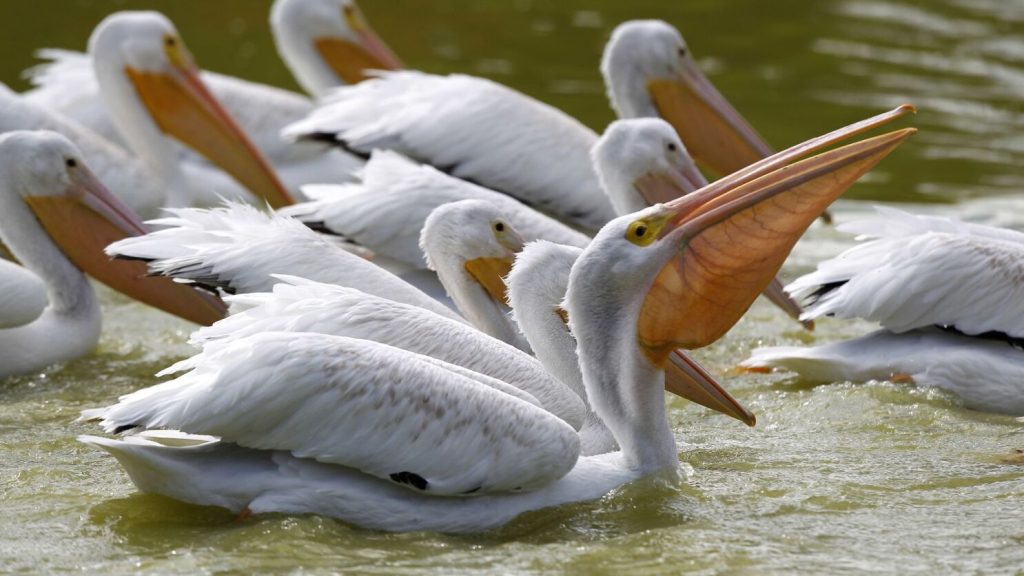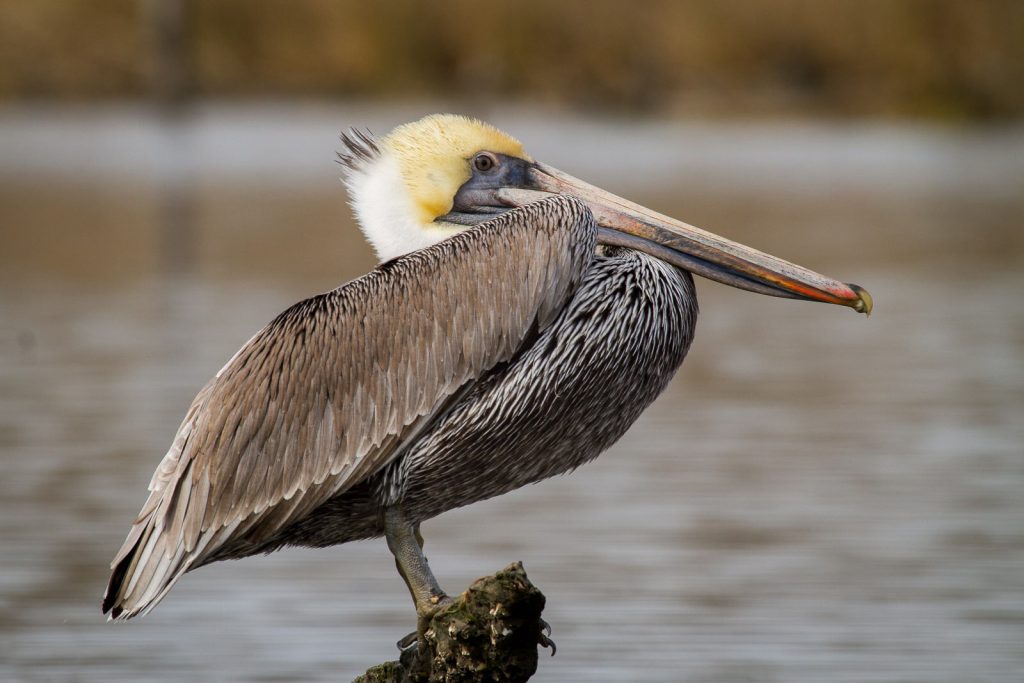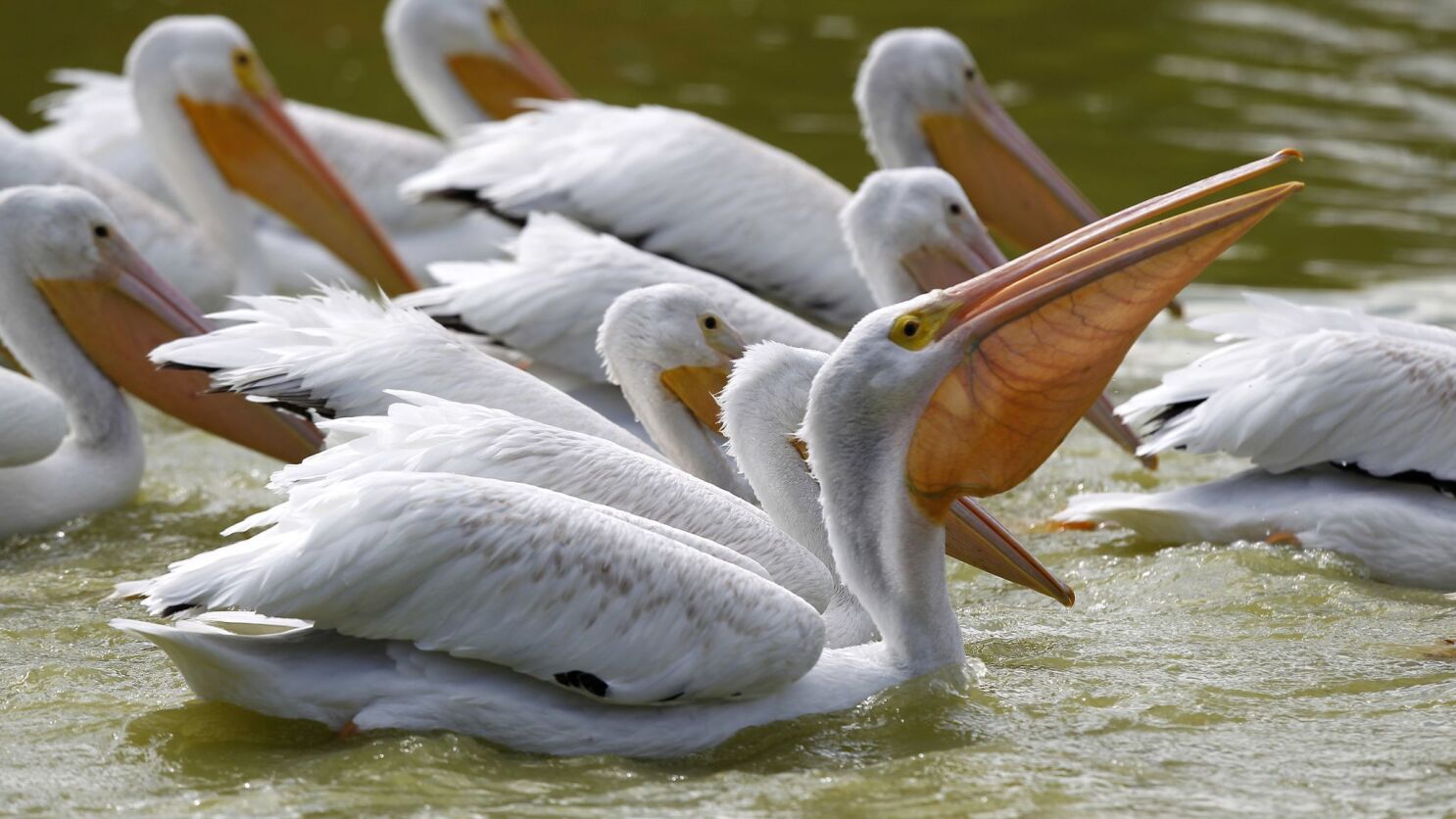Wisconsin is home to two distinct types of Pelicans, namely the American White Pelican and the Brown Pelican. While the American White Pelican can be observed during the summer months, spotting a Brown Pelican in Wisconsin is a rare occurrence.
Pelicans are renowned for their impressive size, notable features such as their enormous bills, throat pouches, and sturdy feet. Despite their large stature, they possess a lightness facilitated by air pockets within their skeletal structure and skin. These characteristics enable them to effortlessly float on water surfaces and glide through the air with their long wings when in flight.
Globally, there are a total of eight pelican species, two of which can be found in North America. These two species are the American White Pelican and the Brown Pelican.
During the breeding season, pelicans undergo fascinating transformations. Their facial skin, throats, and bills take on more vibrant hues, with some even developing additional structures on their bills.
Pelicans exhibit a gregarious nature, often breeding in colonies comprising up to 50,000 individuals. Depending on the species, these colonies may consist of ground-nesting or tree-nesting birds. After approximately 25 days of nurturing in the nest, the young pelicans gather in groups called “creches,” with up to 100 juveniles. Remarkably, the parents possess the ability to identify their own offspring and solely provide them with nourishment.
While pelicans do prey on other animals, they do not fall under the category of birds of prey, which exclusively includes raptors. Fish form the primary diet of pelicans, although they are also known to consume crabs, frogs, snakes, mammals, birds, and insects.
Utilizing their expandable throat pouches, pelicans adeptly capture fish and drain excess water before swallowing their prey. Young pelicans, meanwhile, directly feed from their parents’ throat pouches.
To aid in identifying the pelican species found in Wisconsin, this guide draws information from reputable sources like Avibase and incorporates data gathered from avid bird watchers on eBird. It provides genuine insights into the periods when these avian creatures are likely to be sighted.
Wisconsin’s Pelican Species:
1. American White Pelican

The American White Pelican is typically observed in Wisconsin during the summer season, spanning from March to November. However, a few individuals may remain in the area throughout the year. According to checklists submitted by bird watchers, American White Pelicans have been recorded in 5% of the state’s summer observations.
These pelicans are large birds with impressive wingspans, ranking second in terms of North American avian species.
Non-breeding adult American White Pelicans exhibit a predominantly white plumage, apart from their black flight feathers, which become visible during flight or when the wings are extended. They possess bluish-gray eyes and yellow facial skin surrounding the eyes. Their bills, pouches, and feet display a pale orange hue. Juveniles, on the other hand, feature light gray feathers with darker brown napes.
During the breeding season, adult American White Pelicans display distinct coloration changes. They develop a yellow plate resembling a horn on their upper bills. While their bodies remain white, their eyes, bills, legs, and feet take on a brighter orange hue.
American White Pelicans undergo molting stages known as eclipse. In spring, a visible yellowish patch appears on their breast and chest, while blackish feathers emerge on their heads during summer.
- Scientific Name: Pelecanus erythrorhynchos
- Length: 60 – 63 inches (152 – 160 cm)
- Weight: 246.4 ounces (6983 g)
- Wingspan: 96 – 110 inches (244 – 279 cm)
American White Pelicans breed in remote inland lakes across North America before migrating to spend winters along the southern Pacific Coast of the United States, the Gulf of Mexico, Mexico, and Central America. They can also be spotted during migration in various states across western and central parts of the United States.
You can find American White Pelicans in shallow freshwater lakes, wetlands, and along the edges of lakes and rivers. During winter, they can be observed in coastal bays, inlets, and estuaries, where they forage in shallow waters and rest on sandbars.
Their diet primarily consists of fish, which they skillfully capture by swimming on the water’s surface and using their impressive bills. They also engage in cooperative foraging, strategizing with other birds to drive fish towards the shore, facilitating efficient feeding.
American White Pelicans are opportunistic feeders, adapting their movements to locate food sources. They are capable of covering significant distances in search of optimal feeding grounds. Additionally, they may consume crustaceans, amphibians, and young birds. They have even been observed stealing fish from the water’s surface, pilfering meals from other birds.
When it comes to vocalization, American White Pelicans are generally silent, emitting only occasional grunts. However, the young pelicans can become quite vocal in large colonies, particularly when soliciting food.
Their nests are simple depressions constructed on the ground. The female pelican adds twigs, sticks, reeds, and other materials to the nest as protective layers for the eggs.
The female typically lays one to two eggs, which both parents incubate for up to thirty-six days. Unfortunately, due to siblicide (when one sibling kills the other), only one chick per nest usually survives.
Fun Fact: The impressive bill of the American White Pelican has the capacity to hold up to three gallons of water. When scooping fish from the sea, the pelican tilts its bill downward, draining the water to then swallow the remaining fish stored in its throat sac.
2. Brown Pelican

The presence of Brown Pelicans in Wisconsin is exceedingly rare, with only a few sightings recorded in the state. These pelicans are considered accidental visitors, and the last documented sightings occurred around Prescott Marina and St. Croix National Scenic Riverway in 2012.
Non-breeding adult Brown Pelicans typically exhibit white heads and necks, accompanied by pale yellow foreheads. Their elongated bills display a combination of yellow and orange hues. Their bodies feature a grayish-brown coloration, complemented by short black legs and webbed feet. Juveniles possess brown heads, necks, backs, and wings, while their long bills appear bluish-gray. Their underparts exhibit a light brown shade.
The Brown Pelican consists of five subspecies, with two of them breeding in the United States: P.o.californicus along the Pacific Coast and P.o.carolinensis along the Atlantic Coast.
Distinguishing features between the Pacific and Atlantic Brown Pelicans become more apparent during the breeding season. Both species exhibit white heads with more vibrant yellow foreheads. The color of their napes transitions from white to dark brown. Atlantic Brown Pelicans possess olive-brown throat pouches, while Pacific Brown Pelicans develop red skin on their throat pouches.
- Scientific Name: Pelecanus occidentalis
- Length: 48 – 50 inches (122 – 127 cm)
- Weight: 131.2 ounces (3718 g)
- Wingspan: 78 – 84 inches (198 – 213 cm)
Brown Pelicans either breed and migrate or remain resident throughout the year along the Pacific and Atlantic Coasts of North America, extending down to northern South America.
These pelicans are commonly found in shallow water environments, thriving in estuaries and coastal marine habitats. They can also be observed on mangrove islets, sandbars, breakwaters, and offshore rocks while resting.
Brown Pelicans possess a remarkable foraging ability, enabling them to dive into deep ocean waters to capture prey in their throat pouches. Upon resurfacing, they drain the water from their pouches, allowing them to swiftly consume their catch.
Their diet primarily comprises fish, such as sardines and herring. When not diving, Brown Pelicans leisurely swim and snatch prey using their bills. They may also consume crustaceans like prawns, amphibians, eggs, and other young birds.
When it comes to vocalization, adult Brown Pelicans are typically silent, emitting occasional grunts. However, juvenile pelicans vocalize more frequently, especially when begging for food.
Their nests are often built on the ground, as opposed to trees. These concealed nests can be found on islands, in mangroves, and on cliffs. Females construct the nests using reeds, leaves, pebbles, sticks, and soil. Typically, the female lays two to four eggs, which both parents incubate for approximately a month.
Fun Fact: Brown Pelicans utilize their webbed feet to cover and incubate their eggs. However, this behavior proved detrimental to the species in the past when the pesticide DDT caused thinning of the eggshells, leading to breakages under the weight of their parents’ feet. Numerous conservation efforts were necessary to restore the Brown Pelican population.
